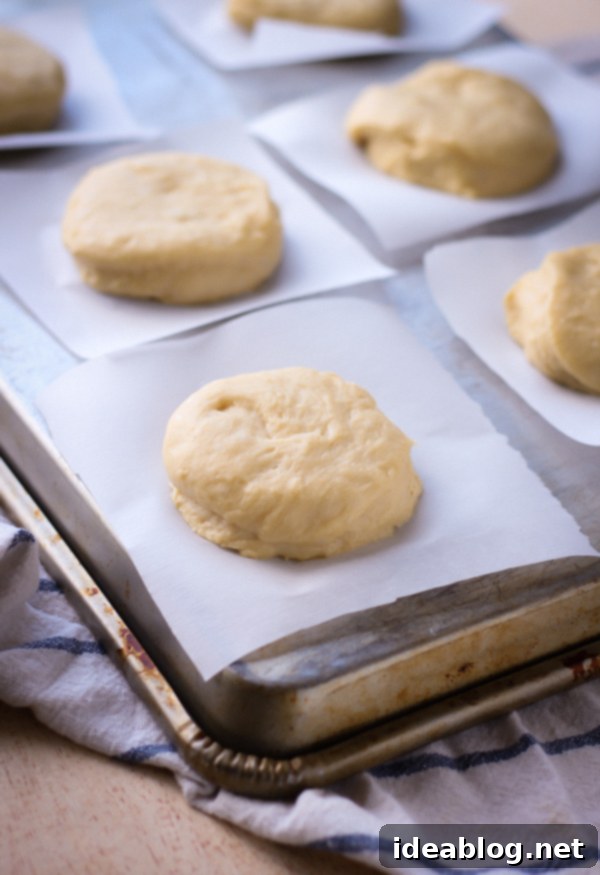Homemade Grapefruit Curd Stuffed Doughnuts: A Zesty Indulgence
Prepare for a truly exquisite baking adventure with these incredible Grapefruit Curd Stuffed Doughnuts. While they demand a little patience and dedication, the reward is an unparalleled explosion of flavor and texture that will make every moment spent in the kitchen utterly worthwhile. Imagine biting into a fluffy, tender, golden-fried doughnut, generously dusted with granulated sugar, only to discover a vibrant, tangy, and lusciously creamy homemade grapefruit curd bursting from its center. This isn’t just a dessert; it’s an experience, a harmonious blend of classic comfort and unexpected citrus zing.

These aren’t your average, run-of-the-mill pastries. We’re talking about authentic, traditional fried yeasted doughnuts, meticulously crafted from scratch. The dough itself is a labor of love, a perfect balance of warm water, active dry yeast, bread flour, a touch of sugar, eggs, and melted butter. This carefully chosen combination yields doughnuts that are incredibly soft, wonderfully doughy, and possess that satisfying chewiness that only a proper yeast dough can deliver. Once fried to golden perfection, each doughnut receives a delicate coating of granulated sugar, setting the stage for its extraordinary filling.

The Allure of Grapefruit Curd: Why This Citrus Stands Out
While lemon curd is a beloved classic, grapefruit curd offers a distinctly unique and captivating flavor profile. It brings a sophisticated tartness that is less acidic than lemon, coupled with a subtle bitterness and a bright, floral aroma that truly elevates these doughnuts. The homemade curd is silky smooth, rich, and perfectly balances the sweetness of the fried dough. Its vibrant, sunny color also adds a beautiful visual contrast, making these stuffed doughnuts as appealing to the eye as they are to the palate. Using fresh grapefruit juice is paramount here, as it ensures the curd’s authentic, lively flavor.
Crafting the Perfect Doughnut Dough: A Step-by-Step Guide
Making yeasted doughnuts from scratch might seem daunting, but with a little care and attention, it’s a rewarding process. The key to light and airy doughnuts lies in the dough. We begin by activating the yeast in warm water with a pinch of sugar. This “proofing” step ensures your yeast is alive and ready to work its magic, creating that beautiful foamy top that signals a good start. After incorporating a portion of the bread flour, the mixture rests, allowing the yeast to begin its fermentation process, developing flavor and strength in the dough.
The subsequent addition of eggs, remaining sugar, salt, and melted butter enriches the dough, contributing to its tender crumb and subtle sweetness. Bread flour is preferred for its higher protein content, which provides the necessary structure for a chewy yet soft doughnut. Kneading is crucial here; it develops the gluten, resulting in a smooth, elastic dough. Don’t be afraid if the dough feels a bit sticky – that stickiness often contributes to a more tender finished product. Over-flouring can lead to dry, dense doughnuts, so resist the urge to add too much extra flour during kneading.
Once kneaded, the dough needs ample time to rise in a warm environment. This first rise, typically around an hour, allows the yeast to produce carbon dioxide, expanding the dough and creating those signature air pockets. A well-risen dough is the foundation for fluffy doughnuts. After the initial rise, the dough is gently pressed or rolled out to an ideal thickness, usually around ¾-inch. Using a biscuit cutter creates perfectly uniform doughnuts. Placing each cut piece on parchment paper squares prevents sticking and makes transferring them to the hot oil much easier. A final short rest, or “second proof,” before frying ensures they puff up beautifully.
The Luscious Grapefruit Curd: Making Your Filling
The homemade grapefruit curd is surprisingly simple to make and adds an incredible depth of flavor. It starts with fresh grapefruit juice, granulated sugar, cornstarch (as a thickener), egg yolks for richness and color, whole eggs for structure, and a pinch of salt to enhance the flavors. These ingredients are whisked together in a saucepan and gently heated over medium-low heat. Continuous whisking is key to prevent scorching and ensure a smooth, lump-free curd. As the mixture heats, it will gradually thicken. Bringing it to a slow boil for two minutes ensures the cornstarch is fully cooked through, preventing any starchy taste.
Once removed from the heat, cold unsalted butter is whisked in, providing a silky texture and glossy finish, while pure vanilla extract adds a delicate aromatic note that complements the citrus beautifully. Straining the curd through a fine-meshed sieve is a crucial step for achieving that perfectly smooth, professional-quality texture, catching any small bits of cooked egg or zest. Allowing the curd to cool completely is important before filling the doughnuts; this allows it to set properly and intensify its flavors. If preparing ahead, store it in the refrigerator, ensuring it’s well-beaten before piping.
Frying for Perfection and Effortless Assembly
Frying doughnuts requires a bit of attention to temperature. Heating vegetable oil in a large Dutch oven to precisely 350°F (175°C) is critical. Too low, and the doughnuts will absorb too much oil, becoming greasy; too high, and they’ll brown too quickly on the outside while remaining raw in the middle. Fry a few doughnuts at a time to avoid overcrowding the pot, which can lower the oil temperature. The parchment paper squares are incredibly helpful here: gently place the doughnut and its parchment into the hot oil; the paper will naturally release after a few seconds and can be removed with tongs. Fry until golden brown on both sides, flipping them once with a slotted spoon or skimmer. Transfer them to a paper-towel-lined sheet pan to drain excess oil, and allow them to cool until they are just slightly warm.
The assembly is the final, delightful step. A thin layer of granulated sugar on a plate is perfect for coating the warm doughnuts; the residual warmth helps the sugar adhere beautifully, creating a sparkling, sweet exterior. For the filling, transfer the cooled grapefruit curd to a piping bag fitted with a round tip. Using a paring knife, make a small incision on the side of each doughnut, creating a pocket for the curd. Insert the piping bag tip into this hole and gently pipe in 1 to 2 teaspoons of the luscious grapefruit curd. The exact amount can be adjusted to your preference, ensuring each bite is perfectly balanced. Serve these magnificent homemade treats immediately for the best experience.
Tips for Doughnut and Curd Success
- Yeast Activation: Ensure your water is warm (around 105-115°F or 40-46°C) but not hot, which can kill the yeast. Cold water won’t activate it properly.
- Don’t Over-Flour: A slightly sticky dough leads to a tender doughnut. Only add flour sparingly during kneading if absolutely necessary.
- Proofing Environment: A warm, draft-free spot is ideal for dough rising. An oven with just the light on can create a perfect warm microclimate.
- Oil Temperature Control: Use a deep-fry thermometer for accuracy. Fluctuations in temperature are the enemy of good fried doughnuts.
- Fresh Grapefruit Juice: Don’t substitute with bottled juice; the flavor will not be the same.
- Continuous Whisking: When making the curd, whisk constantly to prevent lumps and ensure even cooking.
- Cool Curd Thoroughly: A fully chilled curd will be thicker and easier to pipe without making the doughnut soggy.
- Serve Fresh: These doughnuts are best enjoyed the day they are made.
Storage and Make-Ahead Options
While best served fresh, components can be prepared in advance. The grapefruit curd can be made up to 3-4 days ahead and stored in an airtight container in the refrigerator. Beat it well before using to restore its creamy consistency. The doughnut dough can be made the day before and allowed to do its first rise in the refrigerator overnight. Just bring it back to room temperature for about 30 minutes before continuing with the cutting and second proofing steps. Fried doughnuts, without filling, can be stored in an airtight container at room temperature for a day, but they will lose some of their freshness. Once filled, they should ideally be eaten within a few hours.

Grapefruit Curd Stuffed Doughnuts
Pin
Review
SaveSaved!
Ingredients
Doughnut Dough:
- 10 ounces (300 mL) warm water
- 1½ tablespoons active dry yeast
- 4¼ cups (540g) bread flour divided
- 2 large eggs
- 2 ounces (55g) unsalted butter melted
- ⅓ cup + 2 tablespoons (90g) granulated sugar
- 1¾ teaspoons kosher salt
Grapefruit Curd:
- 1 cup fresh grapefruit juice
- ⅔ cup (130g) granulated sugar
- 3 tablespoons cornstarch
- 3 large egg yolks
- 2 large eggs
- pinch kosher salt
- 1½ tablespoons cold unsalted butter
- ¼ teaspoon pure vanilla extract
Assembly:
- 8 cups vegetable oil for frying (roughly 8 cups)
- 1-1½ cups granulated sugar for rolling
Instructions
-
Prepare Doughnut Dough: In a large mixing bowl, combine the warm water, active dry yeast, and a pinch of granulated sugar. Let this mixture proof in a warm place for about 5 minutes, until it becomes visibly foamy. This indicates the yeast is active.
-
Add approximately 1 cup of the bread flour to the yeast mixture and mix thoroughly until combined. Allow this initial dough mixture to sit, uncovered, in a warm spot for 30 minutes. Afterwards, incorporate the eggs, the remaining granulated sugar, salt, and melted butter, mixing well. Gradually add the remaining bread flour, stirring with a large wooden spoon or your hands until a cohesive dough forms.
-
Transfer the dough onto a lightly floured countertop. Knead the dough until it is soft, smooth, and elastic, about 8-10 minutes. The dough will remain somewhat sticky, which is desirable for a tender doughnut; avoid adding excessive amounts of additional flour. Place the kneaded dough into a clean, lightly oiled bowl, cover it tightly with plastic wrap, and let it rise in a warm place until it has doubled in size, which typically takes about 1 hour. While the dough is rising, proceed to prepare the grapefruit curd (details below).
-
Once the dough has doubled in volume, gently transfer it to a lightly oiled countertop. Press or roll the dough evenly until it reaches a thickness of roughly ¾-inch. Using a 3-inch biscuit cutter, cut out individual doughnut shapes. Place each cut doughnut on a small square of parchment paper. Cover the cut doughnuts with a clean kitchen towel and allow them to rest for a final 15 minutes before proceeding to fry them.
-
Prepare Grapefruit Curd: In a small saucepan, combine the fresh grapefruit juice, granulated sugar, cornstarch, egg yolks, whole eggs, and kosher salt. Whisk these ingredients together until thoroughly combined and smooth. Place the saucepan over medium-low heat. Whisk continuously as the mixture heats, ensuring it doesn’t stick to the bottom. Continue whisking until the curd visibly thickens and comes to a gentle boil. Allow it to boil for 2 minutes to ensure the cornstarch is fully cooked and the curd achieves its proper consistency. Remove from heat. Whisk in the cold unsalted butter and pure vanilla extract until fully incorporated and the curd is smooth and glossy.
-
Strain the prepared curd through a fine-meshed sieve directly into a large clean bowl. Use a spatula to press the curd through the sieve to remove any small lumps or cooked egg particles, ensuring a perfectly smooth texture. Allow the grapefruit curd to cool completely at room temperature. If preparing ahead of time, cover the bowl tightly with plastic wrap (pressing the wrap directly onto the surface of the curd to prevent a skin from forming) and refrigerate. Before using, beat the chilled curd well to restore its creamy consistency.
-
Fry and Serve Doughnuts: Heat approximately 8 cups of vegetable oil in a large Dutch oven or deep pot over medium-high heat. Monitor the temperature with a deep-fry thermometer until it reaches 350°F (175°C). Carefully place 2 to 3 doughnuts into the hot oil at a time, using the parchment paper squares to transfer them; the paper will release from the dough after a few seconds and can be removed with tongs. Fry the doughnuts for 2 to 3 minutes on each side, flipping them once with a slotted spoon or skimmer, until both sides are a beautiful golden brown. Transfer the fried doughnuts to a paper-towel-lined sheet pan to drain any excess oil. Allow them to cool until they are just slightly warm to the touch.
-
Spread a thin, even layer of granulated sugar onto a small baking sheet or a wide plate. Gently toss each slightly warm doughnut in the granulated sugar, ensuring it’s well coated on all sides. Transfer the cooled grapefruit curd into a piping bag fitted with a small round tip. Using a sharp paring knife, carefully puncture the side of each sugar-coated doughnut to create a small hole, forming a pocket inside. Insert the tip of the piping bag into the hole and pipe in about 1 to 2 teaspoons of the grapefruit curd, or until the doughnut feels adequately filled. Serve these delicious Grapefruit Curd Stuffed Doughnuts immediately for the best flavor and texture experience.
A Final Indulgence
These homemade grapefruit curd stuffed doughnuts are more than just a dessert; they are a celebration of baking, a testament to the joy of creating something truly special from scratch. The soft, pillowy texture of the yeast doughnut perfectly complements the bright, tangy burst of the grapefruit curd, making each bite an unforgettable experience. They are perfect for a special breakfast, a decadent brunch, or an impressive dessert that will undoubtedly charm anyone lucky enough to try them. Embrace the process, savor the aroma, and delight in the incredible satisfaction of making these unique and utterly delicious treats.


